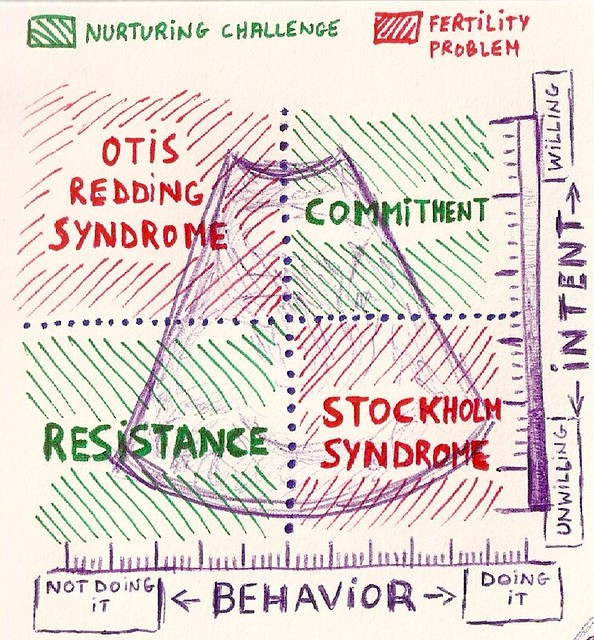The number one behavior you come across in projects is almost never authentic resistance. In fact, resistance is only one of four possible reactions. But it takes a pregnancy test to see it.
Bear with me, as I will show you with the precision of an ultrasound display that it is worthwhile to take urine samples of people who are pissed off.
Like the tests you can buy at the pharmacy, you will be surprised by the accuracy of just looking at two simple things: what people want and what people do. Let’s have a closer look. In the ultrasound display below, the vertical axis displays intent and the horizontal axis shows behavior. As a result there are four quadrants:
- Commitment: what happens when our intention is willing and our behavior follows our intentions. Let’s say this is an authentic ‘yes’;
- Resistance: what happens when our intention is unwilling and when it is in resonance with our behavior. Think about the common types of resistance that are summed up by Peter Block: Need more detail, Giving a lot of detail, Not enough time, Impracticality, Confusion, Silence, Moralizing and Press for solutions. These behaviors demonstrate a ‘no’, but it is an authentic ‘no’.
Both of the above behaviors are signs of pregnancy because they are authentic. Authenticity means that what people do is in sync with what people say. Resistance, like commitment, is a rare behavior. It requires people to be open about what they care about, and at the same time it goes against what is generally accepted. It takes courage to figure out what is not important to you and to say ‘no’ to it and vice versa. But it gets more problematic when there is a dissonance between what people say and what they do.
- The Stockholm Syndrome: The Stockholm Syndrome describes the behavior of hostages who become sympathetic to their hostage-takers. The name derives from a 1973 hostage incident in Stockholm, when several victims began to identify with their hostage-takers as a coping strategy. It is the same kind of fear of repercussions that we can find in some organizations. People lose their sense of self as if they were in a hostage situation and start to act against their unwilling intent. From the outside they gladly execute and commit to the commandments that were made, so the behavior is a false ‘yes’.
- The Otis Redding Syndrome: I borrow this one from Bob Sutton, who recalls the line from Otis Redding’s old song: Sitting By the Dock of the Bay, “Can’t do what ten people tell me to do, so I guess I’ll remain the same”. Clearly, this describes people with a good intention who are somehow hindered to follow their will because they are paralyzed by opinions and politics. This is a false ‘no’.
Otis Redding’s solution was to “remain the same” because he couldn’t please 10 different people. According to Robert Sutton, that is a rational response to a bad system. As for the Stockholm Syndrome; it suffices to quote Rita Mae Brown when she says ‘The reward for conformity was that everyone liked you except yourself’. In other words: not pregnant.
How to Diagnose
So now that you know what to look for we can get down to practice. Intent and Behavior can be in sync or out of sync. It’s all a matter of authenticity – something you can easily diagnose by the level of energy that people display.
When they are in sync (i.e.: ‘I want what I am doing’; or ‘I don’t do what I dislike’), the behavior is authentic and this generates energy. Hence the diagnosis of pregnancy. When they are out of sync (i.e.: ‘I want it, but I am not doing it’; or: ‘I don’t want it and still I am doing it’) the behavior is a coping behavior and it sucks up the energy. Hence the diagnosis of non-pregnancy.
Pregnant: A Nurturing Challenge
Authentic behavior is a source of energy. Most of the times, people are being authentic because it feels safe enough for them to turn their emotions into energy. That is why, from a fertility point of view Resistance and Commitment mean the same:
- People care about the stuff;
- People feel safe enough to tell you they (dis)agree;
- People have a backbone, a beating heart and guts;
In both cases the challenge ahead of us is a nurturing challenge. We need to find a way to channel the energy and provide a context of involvement and sense-making.
Resistance, like commitment, is a good thing although it can lead to a troubled pregnancy. On the other hand, fighting resistance is a form of abortion: you are giving up on the life and you have decided not to create a context for this life to unfold. For sure you will be right when the child is born dead. But who’s to blame?
Not Pregnant: A Fertility Problem
In management, like in medicine, syndromes are mostly conditions that require an outside intervention in order to heal. Something needs to happen before you can think of nurturing. The problem with inauthentic behavior is that there is no context to make sense of the emotions, and thus no fuel. What we see as a result is an alien life-form, as in: alienated and outside of the womb. No nurturing is possible when fertility is the problem.
Solving this fertility problem is the real challenge that organizational change practitioners should focus on. For the biggest part this is uncharted territory because 99% of the practitioners I know make a living out of aborting difficult pregnancies (and claiming they did the right thing).
Real change management is the true work of preparing a womb where behavior can be authentic in the first place. Again, this is uncharted territory for the largest part, but in my version of the truth this womb or context is called a social architecture. Create a context where a ‘problem’ can be a ‘problem’ so we can deal with it without being swept under the carpet.
Whose Baby is it Anyway?
In any project the transfer of ownership of the end state is an awkward thing. In the business world we have gotten used to pregnancies outside of our womb and forced parenthood of someone else’s baby. That is why we need instruments to test authenticity in the first place: to separate nurturing challenges from fertility problems.
Anyhow, the earlier you can get a hold of that urine sample the better it is. So get out there and let the diagnosing begin!
(note: since 2007 I am playing around with this model and the pregnancy test is yet another attempt at getting it across so more people will start using it – so please let me know how that works out for you!)






Pingback: On Tomato Ketchup and Organizational Change | Reply-MC()
Pingback: Sometimes Anger is the Ultimate Commitment | Reply-MC()
Pingback: Getting Serious about Community Development (Part 6) | Reply-MC()
Pingback: HRMblogs.com()